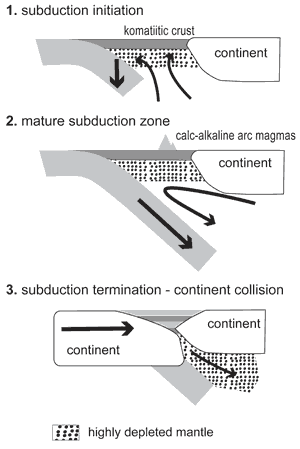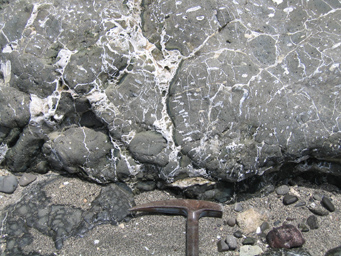Boninite
Boninit is a mafic volcanic rock that is considered primitive andesite. It occurs as an extrusive rock on with a high content of magnesium and silicon in the forearc basin, typically. During the early stages of subduction It is named after the occurrence of the bonuses Islands ( Ogasawara- Gunto ), which form an island arc in the south of Japan.
The rock is characterized by an extreme depletion of incompatible trace elements that can not be transported by wandering through the rock solutions ( the HREE as well as niobium, tantalum and hafnium). In contrast, occur transportable elements such as rubidium, barium or potassium on in varying amounts. Such rocks have been found almost exclusively in the deep sea grave side of young island arcs or in Ophiolithkomplexen that are attributed to former such environments. The characteristic composition is attributed to the melting of altered by metasomatism material from the mantle.
Intrusive rocks of the Archean, which have a similar chemical composition, Sanukitoid are called, they occur together with the rocks several old cratons.
Petrology and Geochemistry
Boninite are characterized by petrological normally visible to the naked eye crystals of pyroxene and olivine in a kristallitreichen, glassy groundmass.
The geochemical composition of Boniniten has the following characteristics:
- Low content of titanium (titanium dioxide <0.5%)
- Silicon content is 57-60 %
- High magnesium to (magnesium iron ) ratio ( 0.55-0.83 )
- Same amount of compatible elements such as the Earth's mantle ( nickel = 70-450 parts per million, chrome = 200-1800 ppm)
- Barium, strontium and LREE are enriched compared to Tholeiiten
- Characteristic ratios of titanium to zirconium ( 23-63 ) and lanthanum to ytterbium ( 0.6 to 4.7 )
Formation
Boninit magma formed by melting already previously melted material in the vicinity of a forearc by hydration of a previously depleted mantle in a mantle wedge above subducted crust that caused the melting of peridotite already veramtem. The extremely low content of titanium on the melting of peridotite is an incompatible element with respect, goes back to the melting of a previously depleted source from the mantle. The first stage of the previous melt normally leads to the formation of tholeiitic island arc basalts.
Boninite acquire their high magnesium and low titanium content by a high proportion of partial melt in the mantle affected by mantle wedge above a subduction zone. The high proportion of partial melt is caused by the high water content of the mantle, as it occurs over subduction zones. The supply of volatiles and incompatible elements from the partial melting of the subducted slab into the overlying mantle wedge of material to the onset of melt processes. The detection of different enrichment or depletion of incompatible elements indicates that Boninite arise from peridotitischem material that has been enriched by metasomatism by LREE, strontium, barium and alkalis. This accumulation could be due to an admixture of material derived from the subducted crustal fragment from either sedimentary rocks or from melted, dehydrated crust.
Boninite can be derived from the residue of a tholeiitic peridotitischem Magmenentstehung, which was enriched before Boninit volcanism by metasomatism of LREE. A second possibility of the formation of island arc - Tholeiiten and Boniniten is the existence of different impoverished peritidotitischen parent material that has been enriched by metasomatism in various degrees. Areas with enriched peridotites would provide in this model tholeiitic magmas, while depleted peridotites Boninite would produce.










